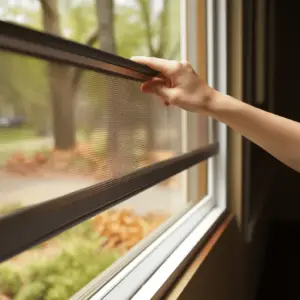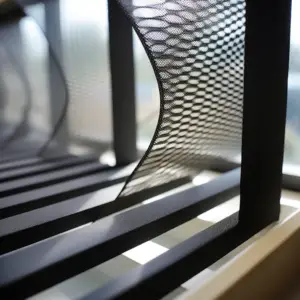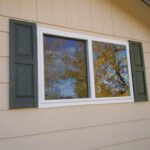Window screen splines, Splines are a vital component in over window screens that secures the screen material into a screen frame. Yes, these lengthy vinyl or foam strips shield you from the numerous horrors of the outside world, such as flies and debris.
However, there are still many questions about splines for which people are looking for answers. This includes inquiries like what distinguishes flat from round splines. This article will address the most frequently asked spline-related questions.
Table of Contents
Flat Spline vs. Round Spline: What is the Difference?

Flat splines have a flat exterior. They are appropriate for framing glass edges and frame surfaces exposed to environmental dangers.
On the other hand, round splines have a spherical, hollow center and serrated exterior edge. Round splines can be used for every size window screen project, whether small or large.
Can Round Window Screen Spline Fit Where Flat Spline is Used?
A circular window screen spline may suit where a flat spline is utilized. However, this relies on the spline channel’s size and form.
A round spline should fit if the channel or groove the flat spline fits in is at least as wide as it is deep and no wider than 0.270 inches.
What Are Prepackaged Screen Spline?
Prepackaged splining is available in a specific length, typically 25 feet, the optimal length needed for a screen door that is 7 feet high and 48 inches wide. A prepackaged polyfoam type is appropriate for house windows and doors constructed in recent decades. The best part is that they are created and built to match specific needs, so if your window spline needs to be a particular shape, size, or dimension, this is your best option.
How Do You Know What Size of Screen Spline to Buy?
If your old spline is damaged, you must buy a new one. To ensure you buy the correct spline size, measure the old spline or the window frame groove. The diameter and width of the spline are all you need to know!
Below are steps on how to measure your old screen spline:
Remove the Old Spline From the Screen
To remove your spline from the screen, start the window’s screen frame. Examine your window screen for clips holding it in place, and if you find any, raise the clips to unfasten the screen from the window. In most circumstances, your window screen frame should readily pop out. If your screen frame is held together with clips, they should be placed on the left and right sides.
After removing the frame, place it on a flat surface like a table. Pry up one end of the screen spline with a flat-end screwdriver. Lift it till your hands can reach the end of the screen spline. The screen spline can be lifted from either end. A butter knife will suffice if you don’t have a flat-head screwdriver. The screen spline resembles a long rubber or foam cord. To remove the screen spline from the frame, pull up on the screen spline with light pressure once you have a firm grasp. Continue lifting the spline until it is entirely removed from the window frame.
As you remove the screen spline, take care not to damage it. The best and most precise readings will be obtained if the screen spline remains undamaged as possible. If the spline is already broken, gently remove it to maintain it as intact as possible.
Finding the Spline’s Diameter
Use the old spline to calculate the new spline measurements. If your screen spline is already damaged, do not discard it. You may still use it to estimate the size of your new screen spline.
If your spline is still intact, use a tape measure to determine its diameter. Place the screen spline on a flat surface and measure the diameter or width of the spline with a tape measure across one end. Measure one side of the spline to the other and write it down.
Depending on whether your country utilizes the imperial or metric measuring system, the spline’s measurements are usually in inches or centimeters.
If your screen spline is significantly broken or you no longer have it, you can alternatively measure the spline diameter using the screen frame. Insert the tape measure into the spline groove opening and take measurements from the bottom to the top to determine the diameter.
The spline groove opening is the location in the screen frame where the spline is inserted.
Purchase a new spline with the exact dimensions. Try to discover the most precise match possible. If your spline dimensions are in the middle of two sizes, evaluate whether the width is closer to the larger or smaller size and select the closest match.
How Do You Install a New Screen Spline?

Below are the steps on how to install a new screen spline: Cut the new spline to size. With a tape measure, measure the length of all four inner sides of the screen. Cut your spline to the same length using scissors or a sharp knife.
If the length of your prior spline is still intact, use it as a supplementary guideline while cutting the spline to size. Put the spline in place. Starting on one corner of the screen, place the spline into the frame groove using your hands. Smooth over any elevated sections with a spline roller to ensure it stays secure. Use grease or stretch the spline to troubleshoot issues. If the spline does not sit flat in the frame groove, spray it with a silicone lubricant available at hardware stores.
If the spline is too large to fit inside the screen, pull it on one end to stretch it thinner as you insert it. The spline should revert to its former shape while maintaining a solid grip on the frame.
Why Are Splines Important?
Splines are crucial because they are the principal component that holds screen material in place over a window. It would be challenging to stay shielded against the outdoor elements if your windows were open without a spline.
This is because the spline installs over the mesh material and acts as a block, preventing the material from moving unless physically pried off with a flat blade screwdriver.
Ensuring that the spline fits is also critical to the success of your fly screen because a spline with the inappropriate diameter for the channel it fits into may compromise the integrity of your screen, leading it to become easily damaged or fall off.


